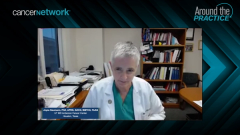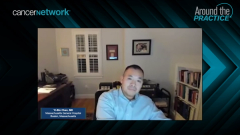
Allotransplantation and Prophylaxis Against GVHD
Experts hold a discussion regarding the timing and onset of acute graft-vs-host disease and chronic graft-vs-host disease following allogeneic transplantation, and prophylactic strategies used to help protect patients.
Episodes in this series

Parameswaran Hari, MD, MRCP: Next up, we need to discuss a little about the symptoms of GVHD [graft-vs-host disease] and how it manifests. Joyce, in your experience, what are the big differences between acute GVHD, symptomatically, and classical chronic GVHD and the overlap?
Joyce Neumann, PhD, APRN, AOCN, BMTCN, FAAN: The acute GVHD manifestations are blurred in terms of when that happens. It may happen after 6 months if the patient is coming off immunotherapy at that point, or usually it’s within that first 3 months. But the acute form is skin with a maculopapular erythematous rash that the patients may exhibit, or GI [gastrointestinal]. Lower GI would involve diarrhea if the patient has cramping diarrhea. The volume is important for us to measure. We use it for some of the scoring criteria. If it’s upper GI, the patient may have nausea, vomiting, or the inability to eat or tolerate substance. And then the liver GVHD is affected. We watch the liver function test, bilirubin, in the early stage and then later. All those things can be very much affected in chronic GVHD.
Sometimes symptoms for chronic GVHD are much more subtle. Patients can experience something like sicca syndrome where they have dryness. Tissues and cells that are supposed to have secretions may not produce those secretions. It can affect almost every organ in the body in terms of some changes, the lungs, (and the) GI tract. The skin is probably, again, the principal. About 67% of chronic GVHD presents in the skin, but there can be multiple organs that are involved, including the eyes, mouth, and vaginal area in our women patients. It’s really a much more complex phenomenon in chronic GVHD.
Parameswaran Hari, MD, MRCP: Thank you so much. You summarized very nicely that acute GVHD typically happens when the patient is still under the care of the transplant team, and it’s often associated with reduction in immunosuppression, sometimes even while the patient is on full immunosuppression within the first few months after transplant. Severe acute GVHD is a major medical problem, and this leads to a significant mortality, whereas chronic GVHD is protean and can manifest in many ways.
I’m always fascinated how variable it can be. It can be something very classical like scleroderma or cutaneous and fascial sclerosis, oral ulceration, dry eyes and mouth, sicca syndrome, all the way to myositis, bronchiolitis obliterans, and everything in between. It’s sometimes very difficult to diagnose chronic GVHD when the transplant team is not keeping an eye (on it). One could say that for a transplanter, everything that happens is GVHD or infection. But if you’re outside, you’d think these patients can go to rheumatologist and internist and many other specialists end up seeing them. GVHD has a major impact on patient outcomes.
With that said, let’s go to the polling question. I’m going to read out the question and the audience needs to (answer the) poll after that. Which is your most common way of prophylaxis offered during allogeneic transplantation? GVHD prophylaxis is a major component of designing an allogeneic transplant. This is really a transplanter’s question, however, it’s just to bring home the point that we think about GVHD and prophylaxing vs GVHD at the time of transplant. The choices are T-cell depletion, anti-thymocyte globulin–based approaches, calcineurin inhibitor and methotrexate, and post-transplant cyclophosphamide. This is too broad a question. Let’s see what the audience thinks.
Let’s discuss this question. I’m going to go back to Nelson. Nelson, GVHD prophylaxis is also changing, and I would say the most common approach is calcineurin inhibitor and methotrexate if you think about at least the matched donor scenario, but we’re increasingly seeing post-transplant cyclophosphamide make an impact there, whereas at least in the US, the T-cell depletion with either ex vivo or in vivo methods are probably less commonly used. Would you want to compare and contrast these quickly for us?
Nelson J. Chao, MD, MBA: Much of GVHD prophylaxis is driven by the transplant center. The transplant center have historical ties. The standard approach still is a calcineurin inhibitor with methotrexate for most ablative regimens. For the haplos [haploidentical], it’s clearly post-transplant cyclophosphamide. Many centers are moving post-transplant cyclophosphamide to other donors as well. It’s an area of flux. The issue of T-cell depletion is very center-specific. Some centers are quite heavy users of T-cell depletion; other centers are not. The bottom line for difference between T-cell depletion and calcineurin inhibitors with methotrexate for the ablated regimen is picking your poison, in a way. Do you look for less GVHD but more relapse or perhaps more GVHD and less relapse? But much of it is center driven.
Parameswaran Hari, MD, MRCP: Absolutely. What’s your common approach at your center?
Nelson J. Chao, MD, MBA: We typically use calcineurin inhibitor and methotrexate for the standard approaches. T-cell depletion is done, usually on a trial, and then for the haplos [haploidentical], we’ve been using post-transplant cyclophosphamide.
Parameswaran Hari, MD, MRCP: We’re very much the same. For the haplos [haploidentical] and mismatched unrelated, we use post-transplant cyclophosphamide, and everyone else at this time we haven’t switched our standard of care in the unrelated donor or the matched sibling donor setting to calcineurin methotrexate. Yi-Bin, what’s the standard at your center?
Yi-Bin Chen, MD: It’s pretty much what you described. For the conventional match donor, we still use standard tacrolimus and methotrexate, reserving post-transplant cyclophosphamide for haploidentical or mismatched unrelated grafts. For the non-malignant patients, which we’re seeing an increased number of, we do use a post-transplant cyclophosphamide-based regimen because we believe that does prevent chronic graft-vs-host disease more. But otherwise, it’s exciting that as a community, we’re doing prospective randomized trials to compare the different regimens against each other. There are a couple of trials done through our collaborative group at CTN [Clinical Trials Network] that will help to define if 1 regimen is superior to the other. We’re all eagerly awaiting (the results of those).
Transcript edited for clarity.
Newsletter
Stay up to date on recent advances in the multidisciplinary approach to cancer.



















































































